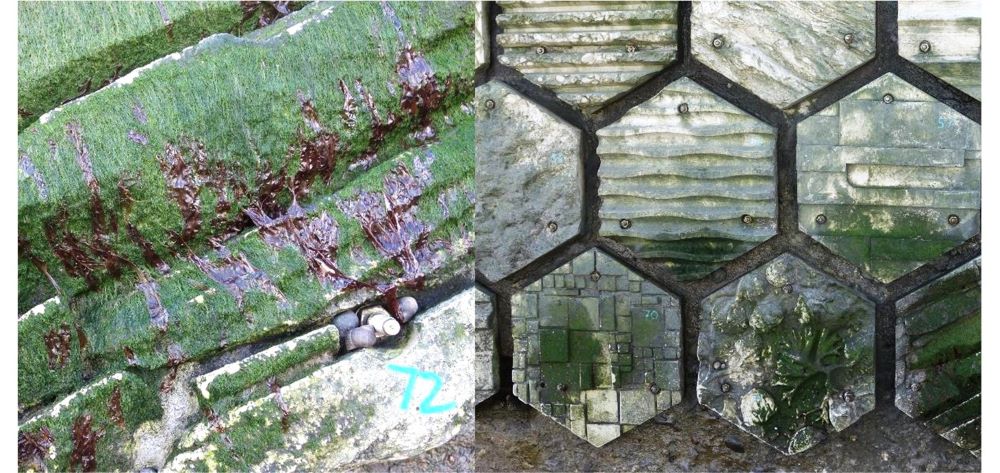
Colonisation by marine species of some of the concrete panels used in the research: (left) green algae, purple laver seaweed, periwinkles, and (right) green algae
As a new seawall takes shape in Mumbles, a village on Swansea Bay, a Swansea University expert has revealed how its design will help encourage biodiversity, thanks to careful research and collaboration.
The upgraded and strengthened 1.2 km seawall will help protect the Mumbles area from flooding and is designed to last for many decades to come.
It will also hopefully become a home for marine species such as seaweed, limpets and barnacles. This is because sections of the wall are being made from concrete panels with ridges and patterns that mimic the rough contours of a rocky coast, providing gaps and crevices where sea creatures can live.
This is known as eco-engineering: including features to enhance biodiversity as part of the design for an infrastructure project.
Dr Ruth Callaway, a bioscientist, led the research to test out which type of panel and location would work best in attracting marine species. Known as the Mumbles Sea Hive project, it involved close collaboration with Swansea Council, which is managing the works, which are largely funded by the Welsh Government, and with the construction company Knights Brown, who were the business partner in this EU funded research project.
Dr Callaway’s research involved placing 135 concrete test panels – hexagonal in shape - on the sea wall in Mumbles, before the building work got under way.
Each panel was cast with one of thirteen different surface textures. The idea was to compare the thirteen designs to see which would do best in attracting marine species.
The panels were erected at 3 different sites on the sea wall 50 metres apart, with some more exposed to the waves than others. At each site, panels were fixed in three rows at different heights, to assess any differences according to how long they were submerged under water.
After a year in place, the panels were analysed and the findings were:
- Panels with a surface of pronounced ridges and a rough structure were best for attracting marine species
- The most common species that colonized the panels were two types of barnacles, which are also common along the rocky coasts of the area
- Periwinkles and limpets used the spaces on - and between - panels for grazing and shelter
- No species colonized the panels that were most exposed to waves
- There was far more marine life on the lowest row of panels, which was submerged under water for longest
The team building the seawall then drew on these findings in making their final decisions for the project.
They chose to use a panel design that was amongst the best performers in attracting marine life. In addition, the final design incorporates hexagonal grooves to provide additional shelter for marine species, in line with the research findings.
The panels are being cast in concrete on site.
Dr Ruth Callaway, honorary research fellow at Swansea University and head of Blue Cube Marine Limited, said:
“It’s great to see this research translated into a major real-life engineering project that will enhance our local environment for generations to come.
The Mumbles seawall is one of the first major engineering projects in the UK to incorporate this kind of research. Swansea Council deserves enormous credit for having the courage and will to make it a reality.
The way in which the project was planned and delivered, with all partners involved – from designers to concrete manufacturers - was vital to its success. We hope this will inspire similar projects.”
Dr Clare Wood from Swansea University, an expert in sustainable construction methods who was also involved in the project, said:
“From its inception the Swansea University Mumbles Sea Hive research project was critical in engaging with and informing the diverse stakeholder group for the Mumbles seawall development. We are excited to continue to work with key partners such as BlueCube Marine to lead research in sustainable engineering innovation and biodiversity enhancement.”
Council cabinet member Andrew Stevens said:
“We're delighted that the new sea defences will both protect the community and encourage biodiversity.
It's great to see the fantastic Sea Hive project taking shape along with the rest of the new-look seawall and prom.
The prom itself will feature lots of new soft landscaping which, along with the existing greenery, will provide noticeable ecological enhancement, making Mumbles yet more attractive to the public and beneficial to the environment."
Eco-engineering - Blue Cube Marine story on the Mumbles Sea Hive project
Swansea University - research in biosciences and civil engineering
